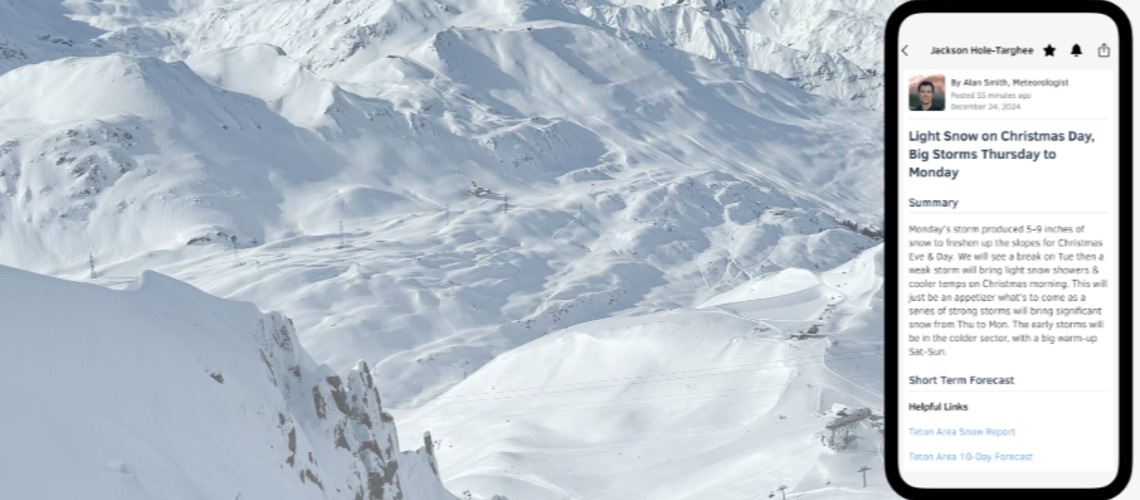OpenSnow Unveils New AI-Powered Real-Time Forecasting

OpenSnow, a trusted source for the most accurate U.S. weather forecasts, snow reports, and AI-powered weather maps, is launching first-of-their-kind new tools this winter that leverage AI machine learning to transform how everyone plans around weather.
One of the most consequential developments is PEAKS, a robust AI-powered weather forecasting system that is up to 50% more accurate than standard forecasting models in mountainous terrain. Updated every 30-60 minutes as new model data is available, users can track precipitation, temperature, and wind forecasts that are adjusted based on each storm’s strength and trajectory. The system leverages OpenSnow’s proprietary forecasting formula to fine-tune 11 weather models used by their professional forecasters and more accurately predict weather conditions.
“Our focus has always been to continually improve forecasting accuracy and make it available and easy for everyone to make safer, smarter decisions,” said Bryan Allegretto, OpenSnow forecaster. “These new AI-powered features are a significant step forward, helping simplify complex weather models so anyone can understand weather risks and timing with greater detail and accuracy.”
Additional forecasting tools OpenSnow will introduce this year reveal even more details behind each forecast:
- PEAKS Avy- An AI-powered avalanche forecast model, PEAKS Avy will produce an overall danger rating and identify potential avalanche “problems” for eight aspects and three elevations per avalanche forecast center “zone.” This model, informed by the work of human avalanche forecasters, has automated the forecasting process to enable updates multiple times per day.
- PEAKS Snow - Want to know when the snow is expected to turn from powder to chalky or grippy conditions? PEAKS Snow was designed to convert complex weather and snow data into an easy-to-understand graphical and textual description with nuanced snow quality details that skiers and riders may experience.
- 15-Day Forecasts - Generated from OpenSnow’s new PEAKS weather forecasting system, detailed, multi-model 15-day weather forecasts for any location and elevation on Earth now allow OpenSnow users to compare forecasts for their favorite ski resorts, backcountry locations, camping destinations, or current location. Compared to other weather predictions, OpenSnow now offers a look into five more days than the average forecast.
- Forecast Range - Offering a 15-day outlook, new Forecast Range Graphs provide a multi-model comparison of every global and regional weather model in OpenSnow, generating a clear view into whether forecast models are in tight agreement (higher confidence) or show a wider spread (lower confidence). Power users can also use the graphs to isolate favored models to dig further into scenario details.
- Forecast Global Radar - Providing a worldwide, 15-day outlook, Forecast Global Radar explores precipitation type forecasts in 2D or 3D for any location on Earth. Powered by the ECMWF (European) model, it is updated every 12 hours with the latest available forecast data and can be used to improve trip planning, event logistics, and commute readiness over land and water
- Forecast Snowfall Maps - For any location in the U.S. and southern Canada listed on OpenSnow, users can visualize expected snow totals in 2D or 3D for the upcoming 6, 12, and 24 hours, plus total snowfall over the next 10 days with Forecast Snowfall Maps. These maps are incredibly useful for those interested in timing storm arrivals to know where to find the deepest powder day turns, when to avoid hazardous driving conditions, and to see which ski areas are favored to receive the biggest snow totals. The high-granularity timing can also help resorts optimize their operations.
- AI “Personal Forecaster” - An AI-powered predictive description of the weather and snow that a skier or rider will likely experience on the mountain, AI Personal Forecaster leverages OpenSnow’s proprietary weather data to write detailed forecasts winter sports enthusiasts will want to read.
“In the development of PEAKS, we had the system go back through 40 years of data to look for bias and errors in past forecasts so that it can make more accurate predictions in the future. We have found that using the AI model to make changes has resulted in forecasts being up to 50% more accurate,” continued Allegretto.
These AI-enhanced weather forecasting features, plus OpenSnow’s robust, expert forecasts, are or will soon be available on the OpenSnow App that can be downloaded on the Apple App Store or Google Play.
Since 2011, OpenSnow has been a trusted source for the most accurate U.S. weather forecasts, snow reports, and now, AI-powered severe weather maps. The platform pairs expert meteorology with advanced modeling to deliver clear, actionable insights for millions of everyday users and professionals who depend on precise weather information. Learn more and download the free OpenSnow App at opensnow.com.













